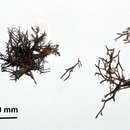en
names in breadcrumbs


Amphiroa is a genus of thalloid red algae under the family Corallinaceae.
Amphiroa was first described by Jean Vincent Félix Lamouroux in 1812 with the type species for the genus being Amphiroa tribulus[1]. This genus was named after Amphiro, a sea nymph in the epic poem of Theogony by the Greek poet Hesiod.[1][2] There is currently 72 accepted species names for this genus.[2]
Amphiroa is composed of an erect thallus that is attached to the substrate with an insconspicous crustose base and possess mature branches differentiated into alternating areas calcified intergenicula and uncalcified genicula that is composed of more than cell layer and does not exhibit any dimerous flange-like branches.[3][4][5] Specimens can reach around 30 cm in size. The thalli take a crustose form; dichotomous branches are formed. The organisms possess secondary pit connections. Amphiroa reproduces by means of conceptacles; it produces tetraspores. Its pore canals are lined with parallel filaments; the morphology of the pore canal is a key trait used to delineate species within the genus.[6]
Amphiroa is a cosmopolitan genus inhabiting the tropics up to the temperate regions.[4][5]
This genus is found from the intertidal down to the subtidal areas of the reef.[5]
Amphiroa exhibit a triphasic life cycle, however, their tetrasporangia, spermatangia, and carposporangia are borne out of a specialized organ called a conceptacle. This triphasic cycle involves the production of tetraspores (N) from the tetrasporophyte (2N) and the subsequent development of the tetraspores into either the male or female gametophyte (N); resulting spermatium produced by the male gametophyte is later on trapped by the trichogyne of the female gametophyte leading to their eventual fusion and development of the carposporophyte (2N); the cycle is complete when the carpospores (2N) are released and develops into the next set of tetrasporophytes.[5][7]
Amphiroa species are unpalatable due to its thallus being highly calcified and thus there is no immediate cultivation and use for the seaweed.
Amphiroa contains several bioactive compounds similar to other seaweeds, for example, the ellagic acid, gallic acid, and phenolic compounds within A. anceps has shown to be a potential anti-fungal agent,[8] moreover, addition of A. fragilissima polysaccharides have shown to improve the gut of farmed shrimp.[9]
This genus is currently not being utilized and managed on a commercial scale due to a lack of culture technology.
The valid species currently considered to belong to this genus are:[10]
Amphiroa is a genus of thalloid red algae under the family Corallinaceae.